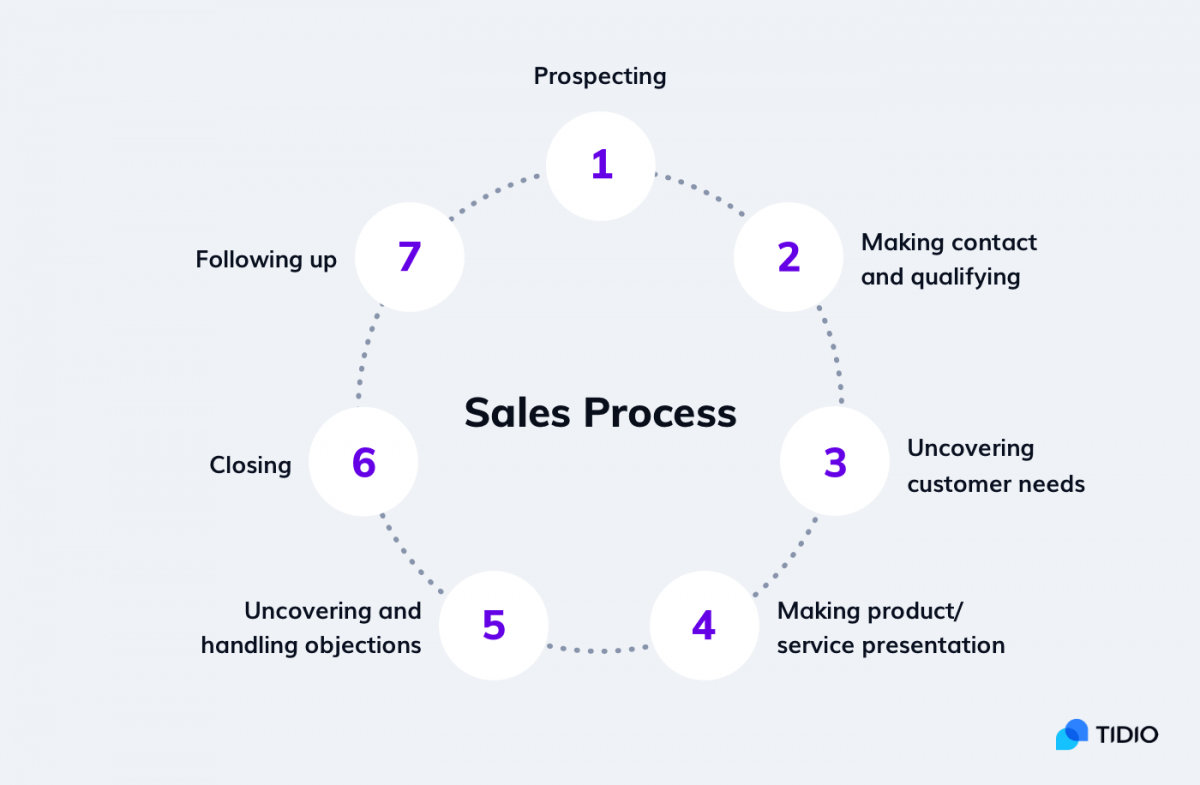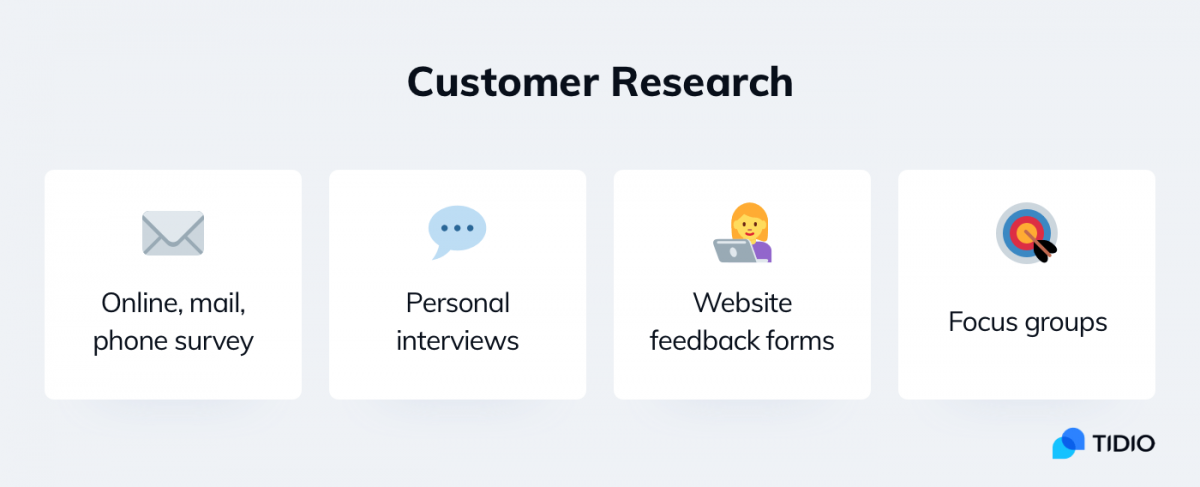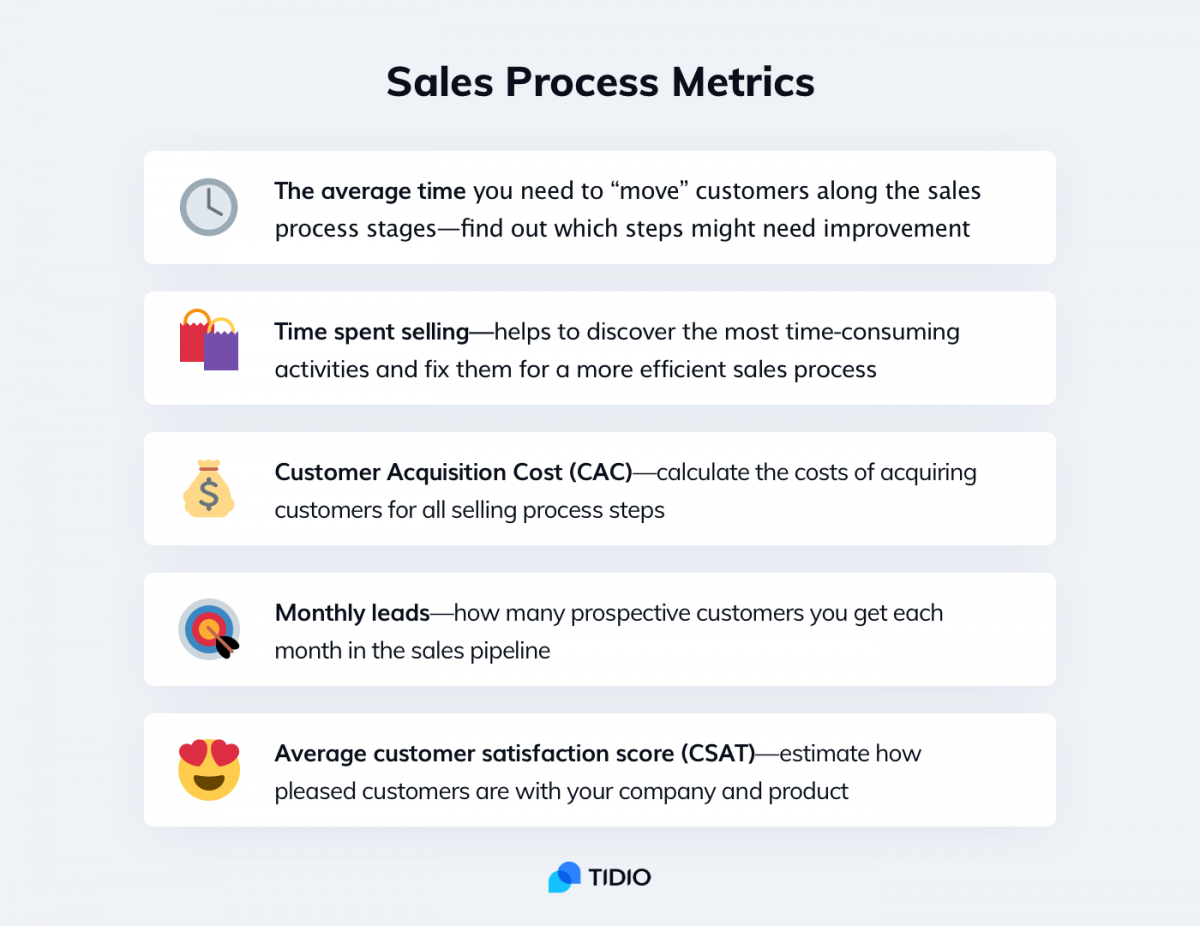You might be working too hard to make sales.
Wait… is there such a thing as “working too hard” to sell?
Well, your sales process should be buttery smooth, and super effective, rather than hard.
In this guide, we’ll show you how to map it out to make the most of it. And much more.
Engage your customers online just like if they were visiting your physical store
What Is the Sales Process?
A sales process is a repeatable, well-structured sequence of actions taken by a salesperson to convert prospects into customers. The most effective sales processes have between 5 and 7 steps: Prospecting, Qualifying, Approaching, Presenting, Objection Handling, Closing, and Following Up.
We’ll focus on the seven-step sales process, as it covers more essentials compared to the five-step one.
The Seven Steps of the Sales Process
Here are the 7 steps of selling processes to move a customer along the sales funnel:
- Prospecting
- Making contact and qualifying
- Uncovering customer needs
- Making product/service presentation
- Uncovering and handling objections
- Closing
- Following up
Now, take a look at this sales process flowchart with the seven steps–it illustrates how a typical sales cycle works.

1. Prospecting
The first step in the sales process is to search for and find potential customers. Also called “lead generation,” it’s how you start relationships with customers.
Most businesses use pre-defined criteria for customers to designate them as the so-called “qualified prospects.”
A qualified prospect is someone who expressed interest in your company, e.g.:
- Subscribed to a newsletter
- Asked your customer support a question
- Opened an email sent by your company earlier
- Visited your website
- Mentioned a key phrase relevant to your business on social media
- Downloaded a lead magnet (e.g. a business guide)
Apart from “qualified prospects,” there are “cold prospects”—those who haven’t expressed any interest. These folks are another story. For cold prospecting, salespeople use LinkedIn for prospecting or search for information in such sources as:
- Company news analysis
- Interviews with decision-makers
- Analyses of company-related content via third-party resources
- Social media research
The information from any of these resources could prove helpful to qualify and later add the leads into your sales process.
Prospecting is all about starting customer relationships. To become better at fostering positive relationships read 7 Ways to Build Strong Relationships With Customers
2. Making contact and qualifying
The next step of the sales process is to contact the qualified prospects of your choice to evaluate their real potential. At this stage, you need to ask key questions about your prospects’:
- Needs
- Goals
- Authority to buy
- Ability to buy
Focusing on these aspects is critical to understand if the lead is a good fit for your business.
What are good qualifying questions to ask?
Try these:
- What issue are you currently facing?
- What solutions and strategies have you tried in the past?
- What are you hoping to achieve with a new product or service?
- What would be the outcome if you didn’t solve the problem?
- Do you have any requirements for working together?
While listening to the prospects, look for clues indicating their potential.
An effective practice is to assign a grade to prospects (cold, standby, hot) based on the received information.
Step 1: Add a chat plugin to your store/website to connect with your visitors.
Step 2: Answer question and talk to your customers in real time.
Step 3: Close more sales and track how live chat helps your business.
Try Live ChatTo make contacts and qualify prospects in eCommerce, try live chat. Send personalized messages to website visitors to ask qualifying questions, in real-time.
3. Uncovering customer needs
There’s no better way to discover your prospects’ needs and goals than a sincere conversation. To encourage the prospect to share, you can use the Challenger method, and ask open-ended questions. And, of course, get ready to listen—never interrupt unless absolutely necessary.
If a salesperson “takes the stage away from the prospect,” they’re:
- Not learning about the customer needs
- Not raising issues that the prospect might be experiencing
- Risking to miss customer’s concerns and buying clues
- Making it more difficult for themselves to convince the prospect to buy.
Make a checklist of key areas you want to explore to prepare your questions for the sales presentation.
Consider such questions as:
- What are the needs/challenges of my customer?
- How can my product/service help them meet these needs or overcome challenges?
- How will my product/service can make them more competitive?
- How can I communicate these benefits to my customer in a way that makes them realize the value of my product?
During the conversation, verify your understanding of prospect needs by summarizing their answers. After a prospect answers your question, briefly recap their response.
4. Making a product/service presentation
A product or sales presentation is a meeting where you share the benefits, advantages, and use cases with potential customers. Some of the latest sales Chrome extensions can help you in the process of making such presentations and deliver your best value.
Sales presentations can happen in person, via email, phone, or live chat—depending on customer preferences.
During the presentation:
- Restate the main goals of the customer
- Describe main product/service features as ways to achieve customer’s goals
- Explain how your product will help the customer become more competitive.
Why restate the customer’s goals first? The customer decides whether to really listen during the first several minutes. So, the first sentences you say affect your ability to make the sale.
To grab the attention from the beginning, you must be able to relate directly to the customer’s current challenge or goal.
Next, focus on the benefits that matter the most to the potential customer.
Try using case studies to explain how your product could help become more competitive. Case studies are engaging and contain specific results, which is something that customers could be interested in.
One of the ways to master the art of presentations is to learn from the best. Here are some resources to help you out:
- Resonate and slide:ology Nancy Duarte
- The Presentation Secrets of Steve Jobs by Carmine Gallo
- 5 TED Talks to Watch Before Giving a Presentation
Mention your company’s reviews during sales presentations—they increase customer trust. Get more reviews: 7 Tips to Get More Business Reviews
5. Uncovering and handling objections
This sales process step is about responding to customer questions and objections after the presentation. Being prepared is key to convincing the customer to make a deal.
The most common objections are:
- “It’s too expensive.” Handle price-related objections by demonstrating the value for the money
- “We never heard about your company.” Counter a lack of trust by doubling down on the value your product/company gives
- “We don’t need this product right now.” Turn this objection into an opportunity to impress the customer by giving specific reasons how they can benefit
- “We’re not planning to solve this problem now.” Handle this by asking them for more details, and finding reasons why delaying a solution could be risky.
Objections are a part of the selling processes in every industry. So, learning how to handle them is a must-have skill for making sales.
Best-rated books to learn persuasion:
- Influence: The Psychology of Persuasion by Robert Cialdini
- Getting to Yes: Negotiating Agreement Without Giving In by William Ury & Roger Fisher
- The Sales Magnet: How to Get More Customers Without Cold Calling by Kendra Lee.
Objections occur during every sales cycle and might make you struggling to find answers. In this case, try to re-schedule your sales meeting to get all the answers for the customer.
Plan for and anticipate objections. With customer segmentation, you can learn more about the needs and goals of your customers—and be better prepared during the presentation.
6. Closing
As Alec Baldwin’s character in Glengarry Glen Ross said:
Always. Be. Closing.

This means: obtain the commitment to purchase by getting interest, attention, and decision from the potential customer.
Here, the way you handled the objections will prove critical. If you did a great job, then you silenced the doubts about your offer—and the customer is likely to commit.
Ask these questions to determine the prospect’s true interest:
- “Seems like [your product/service] can help your business. What do you think?”
- “If we make a deal today, I can reassure you that we’ll [deliver on a special request from the prospect]. What do you say?”
- “If you’re interested in [your product/service], you can start with [benefit A] and [benefit B] by [date or timeline]. How does that sound?”
- “Have I done enough to convince you that [your product or service] is the right fit for you?”
If the prospect is not interested in your offer, a closing question makes it easier for them to end the conversation. But if they recognize the value of your product, the question could push the prospect to make a decision.
Still see hesitation from the prospect?
These might help:
- “What timeline can you give me for your decision?”
- “What will it take me to win your business?”
- “Let’s work out the concerns you have and get started”
- “With your approval right here, I can give you a delivery date for your new [product].” Would you like to sign right now?”
- “Won’t you be glad to have a [product] and start using it as soon as tomorrow?”
Get some minor agreements before asking these questions–you’ll make it easier to get a “yes.”
Read more: Check out the best strategies to improve your pre-sales support.
7. Following up
The final step in the sales process is contacting the buyer after they made a purchase.
It’s the beginning of your business’s relationship with the customer, which ideally should be long-lasting and positive.
To ensure such a relationship and make the customer loyal, follow up on every interaction. By doing so, you’ll discover potential issues and serve customers better.
Within all sales cycles, your business will follow up with clients via email. Try these to write useful and engaging follow-up emails: 7 Effective Follow-Up Techniques to Increase Conversions (Without Being Annoying).
Best Practices for Creating Your Sales Process
Whether you’re running a small startup or a big online store, a repeatable, structured sales process is a must to increase sales.
Let’s learn how to build one to make selling easier for yourself in the long term.
1. Create a map of sales process steps
The first step is to lay out the stages of your selling process.
There is no universal number of steps in the sales process—it depends on your industry, business, and product. Many people choose a 7-step sales process, so it’s a good starting point for your business.
Map out these sales steps and describe them for your business. Make sure your descriptions consist of the exact activities you’re going to undertake at each stage.
- Prospecting
- Making contact and qualifying
- Uncovering customer needs
- Making product/service presentation
- Uncovering and handling objections
- Closing
- Following up
Why seven steps in the selling process, you ask?
A short sales process with fewer than three steps doesn’t cover everything in the relationships between businesses and different types of customers.
And, if there are more than seven stages, you might be overcomplicating it. In this case, the sales management process might be more challenging.
2. Adapt to different customer needs
Make your basic sales process reflect the way customers prefer to interact with and buy from your company.
This means taking a look at the buyer’s journey to understand:
- How they communicate with your brand
- What problems they solve with your product or service
These two things will help to adapt your product sales process to customer needs.
Customer journey analysis is another source of insights. For example, your team can learn where to contact customers and the information to handle objections better.
Adapting to customer needs is easy when you know them. Here’s an article that will help you: Types of Customers [And How to Satisfy Their Needs]
3. Use customer research
Research is what helps to make offers that your customers can’t refuse. That’s why it’s part of the competitive sales points in addressing customers’ needs.

Effective strategies to capture the voice of the customer are:
- Online, mail, or phone surveys
- Personal interviews
- Website feedback forms
- Focus groups
The insights you’ll discover could be key.
For example, you might find that your prospects prefer to be contacted via social media. This study by Jim Keenan, a social sales expert, says 78.6% of salespeople who use social media outperformed those who didn’t.
Places to get custom research insights:
- Mention—social media listening tool for learning and monitoring social sentiment (how consumers talk about your brand)
- Pew Research Center—a reliable source of statistical data from national studies
- Survey Monkey—a popular tool to get insights via online surveys
- Facebook Audience Insights—a market research tool with data on consumer behavior and demographics
- National Retail Federation—find lots of surveys about retail industry trends, customer behavior, and consumer sentiment.
4. Choose tools for each sales process step
Sales tools automate time-consuming processes and increase your reach. For example, you can communicate and qualify more customers quickly with live chat.
Helpful tools for sales process automation:
- Tidio—live chat, chatbots, and email marketing for qualifying prospects and learning about their preferences and needs
- Hubspot CRM—for prospecting, making contact & qualifying, and creating a unique 7 step sales process
- Sharekits—proposal and content sharing for making sales presentations and tracking customer engagement
- Detective by Charlie—a tool for collecting information about prospects to speed up the work of sales reps
5. Measure and improve sales process results
Making a sale is just a step along the way.
Once you’re done with sales process mapping and implementing the 7 stages, look for opportunities to score even more sales.

To evaluate your sales process performance, try these metrics:
- The average time you need to “move” customers along the sales process stages—find out which steps might need improvement
- Time spent selling—helps to discover the most time-consuming activities and fix them for a more efficient sales process
- Customer Acquisition Cost (CAC)—calculate the costs of acquiring customers for all selling process steps
- Monthly leads—how many prospective customers you get each month in the sales pipeline
- Average customer satisfaction score (CSAT)—estimate how pleased customers are with your company and product
To score more sales, make changes to your standard sales process based on your measurements.
The average customer satisfaction score is a strong predictor of purchase behavior. Learn how to calculate it: 6 Steps to Measure Customer Satisfaction [Metrics, Pros & Cons]
Sales Process: Summary
A sales process is a sequence of steps a salesperson takes to make a sale while meeting customer needs and building a long-term relationship. Common sales processes include five or seven steps, depending on the product or service.
The 7 steps of the sales process are:
- Prospecting
- Making contact and qualifying
- Uncovering customer needs
- Making product/service presentation
- Uncovering and handling objections
- Closing the deal
- Following up
Your prospects have different needs, so having a good selling process will help figure them out and work toward that.
Engage your customers online just like if they were visiting your physical store

